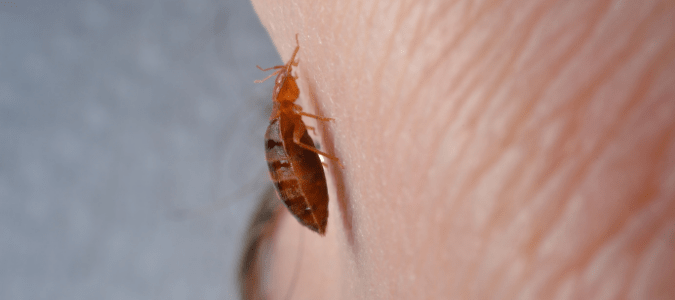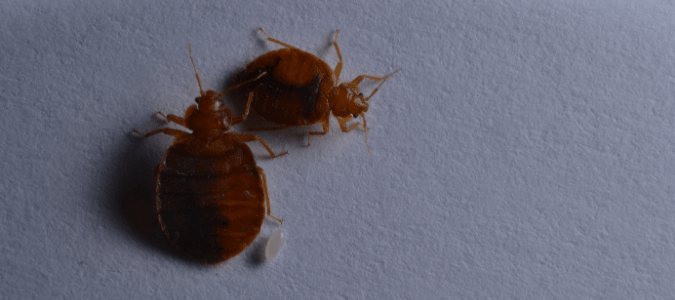Bed bugs may be tiny creatures, but they can cause a large problem if you don’t catch them early on. Unfortunately, they can be hard to spot and identify. It’s easy to mistake other creepy crawlies like ticks, carpet beetles and baby roaches for bed bugs. It also doesn’t help that bed bug bites look similar to other insect bites and skin conditions like fungal infections and eczema. The longer you take to detect them, the more time they have to spread to other parts of your home.
Below is a guide on how to inspect for bed bugs. Learn about the most common signs of an infestation, what they look like, where they like to hide and how to prevent them from invading your space. If you have confirmed their presence in your home, it’s time to contact pest control professionals for help. It is hard to manage an infestation yourself, but the experts will know what to do.
What Are Bed Bugs?
Bed bugs are small insects with oval bodies and a brownish hue. Adults are flat and have the rough dimensions of an apple seed. They survive solely on human and animal blood, swelling and turning reddish after a feeding session.
They’re most active at night and tend to bite sleeping humans, puncturing their exposed skin and extracting blood. Their bites usually aren’t painful, but they can become red and itchy later. While bed bugs can’t fly, they are fast on their feet and can crawl quickly on walls, floors and other surfaces. These blood suckers are annoying, but fortunately, they don’t transmit diseases.
Many homeowners are surprised to learn just how fast bed bugs multiply . Female bed bugs can lay around a hundred eggs in their lifetime, each no bigger than a speck of dust. Their nymphs undergo five cycles of skin shedding and need to feast on blood before each one. If they are living in a favorable environment, baby bed bugs only need around a month to fully mature and reproduce.
What Are the Most Common Signs of a Bed Bug Infestation?
The best proof of a bed bug infestation is seeing these insects with your own eyes. However, they are fast and tiny, so it can be difficult to confirm their existence in your home. But if you’re waking up with itchy spots on your body that weren’t there before you went to bed, that could be one indicator. According to Alan Brown, Board Certified Entomologist and Technical Director at ABC Home & Commercial Services, telltale signs of an infestation include the following:
- There are reddish or rusty brown blots or smudges on your pillowcases, bed sheets and mattresses. These are blood stains from when people are bitten in their sleep.
- There are small black dots on your bed and surrounding areas resembling marker stains. These are bed bug excrement.
- There are bed bug eggs , egg shells and shed skin in the nooks and crannies of your bed and surrounding areas.
- You can smell a strong, musty odor. Bed bugs secrete this smell from their scent glands.
If you notice any of these signs, it is best to consult pest control experts . That way, they can nip it in the bud before the bed bug issue escalates into a bigger problem.
Where Do Bed Bugs Usually Hide?
Bed bugs are no thicker than a credit card, so that should give you an idea of all the spaces they can access. If you suspect you have bed bugs at home, inspect all areas thoroughly to see how far they have spread. With the help of a few household items, you can find these tiny insects, or at least their skin shedding and feces, and clean up as you go.
A flashlight will be a big help in your search. It will allow you to inspect dark cracks and crevices where they may be hiding. It’s even better if you have a magnifying glass. Next, find a flat-edged tool like a credit card or small knife that you can use to scrape the bed bugs out of their hiding places .
Have some paper towels and a plastic bag nearby, so you can easily discard the bed bugs you find. You can also use a vacuum with a crevice attachment to help you clean up. Lastly, prepare a sponge and soapy water to wipe down any bed bug stains. That way, you will immediately know if there is a reinvasion of the area. Once you’ve gathered these materials, here’s how to inspect for bed bugs:
- Start with your bed. Bed bugs love warm spots and tend to get comfortable in mattresses. Inspect all areas of your bed, including the seams, sides, underside and behind the headboard. Check your pillows, sheets and blankets for any signs, too.
- Search the furniture in your bedroom. Bed bugs prefer spots where humans stay for long periods, including couches, office chairs and recliners.
- Look around the bedroom. Bed bugs can hide in cracks and on the edges of baseboards, doors, windows and carpets. They can also live in and under small objects like books, toys and clocks.
- Move from the bedroom to the other areas in your home to see where else the bed bugs have spread. Stop only when you don’t see any more signs of them.
Once you have confirmed that there are bed bugs in your home and know how far they’ve spread, contact pest control professionals so they can handle the situation.
Will Bed Bugs Go Away on Their Own?
Some problems go away on their own. But unfortunately, this does not apply to bed bugs. Ignoring the infestation in your home will only make the problem worse. As long as bed bugs have food, which they get from you, they’ll stick around and make you miserable.
The best course of action is prevention. Bed bugs are excellent hitchhikers and will enter homes by riding in purses, luggage and other objects that you place on soft surfaces or upholstered furniture. They can also transfer from one apartment unit to another through various entry points. Here are some tips to help slow the spread of bed bugs in your home and how to prevent their arrival in the first place.
Get Rid of Hiding Spots and Block Off Entryways
- Vacuum all areas of your house regularly, especially behind and under your bed. Empty the contents of the vacuum bag into a sealed plastic bag and dispose of it outside immediately.
- Wash your pillowcases and bed sheets regularly and leave them for 30 minutes in the hot dryer.
- Fix hanging electrical faceplates and remove or replace peeling wallpaper.
- Inspect your walls, doors, ceiling, bed frame, baseboards and furniture for any cracks and crevices and seal them off.
Be Mindful of the Things You Bring Into Your Home
- If you purchased a mattress from the store, inspect it before bringing it into your new home. Even if it’s new, it might have been in a delivery truck with old mattresses. To be safe, you can ask them to seal it with a plastic film before they deliver it.
- Be careful about purchasing refurbished or secondhand furniture. It is best not to take a sofa or mattress from a curb.
- Inspect items you are bringing into your home for the first time, whether a secondhand book, an antique trinket, clothing from a thrift store or a garage sale item.
- If you are helping someone move, check the items before you bring them into your car.
Can Bed Bugs Get on Air Mattresses?
Bed bugs aren’t picky when it comes to mattresses. They will make a home out of any kind, including air mattresses. People may think they can’t climb air mattresses because of the smooth plastic on the sides. But unfortunately, this material isn’t slippery enough to discourage them. They might even have an easier time ascending air mattresses because they are usually on the floor. There is especially not stopping them if your blanket is touching the ground.
If you have an existing bed bug infestation, you can’t solve the problem by buying an air mattress. They will invade it as well. Even if the seams on air mattresses are not as deep, they are still a suitable home for these pests.
The Bottom Line
Now that you know how to inspect for bed bugs, you can determine if you have an infestation at home and how far it has spread. The only way to solve this problem is by controlling the entire population. If you don’t, they will continue to reproduce and wreak havoc. It can be extremely challenging to solve the situation yourself, but you don’t have to face it alone. The best thing to do is to contact a bed bug control professional who can do the job for you.
ABC Can Control Your Bed Bug Problem
Bed bugs are annoying pests that are hard to control on your own. When you notice an infestation, contact ABC Home & Commercial Services for pest control services . We have multiple strategies to control bed bugs, so you and your family can be comfortable again.


